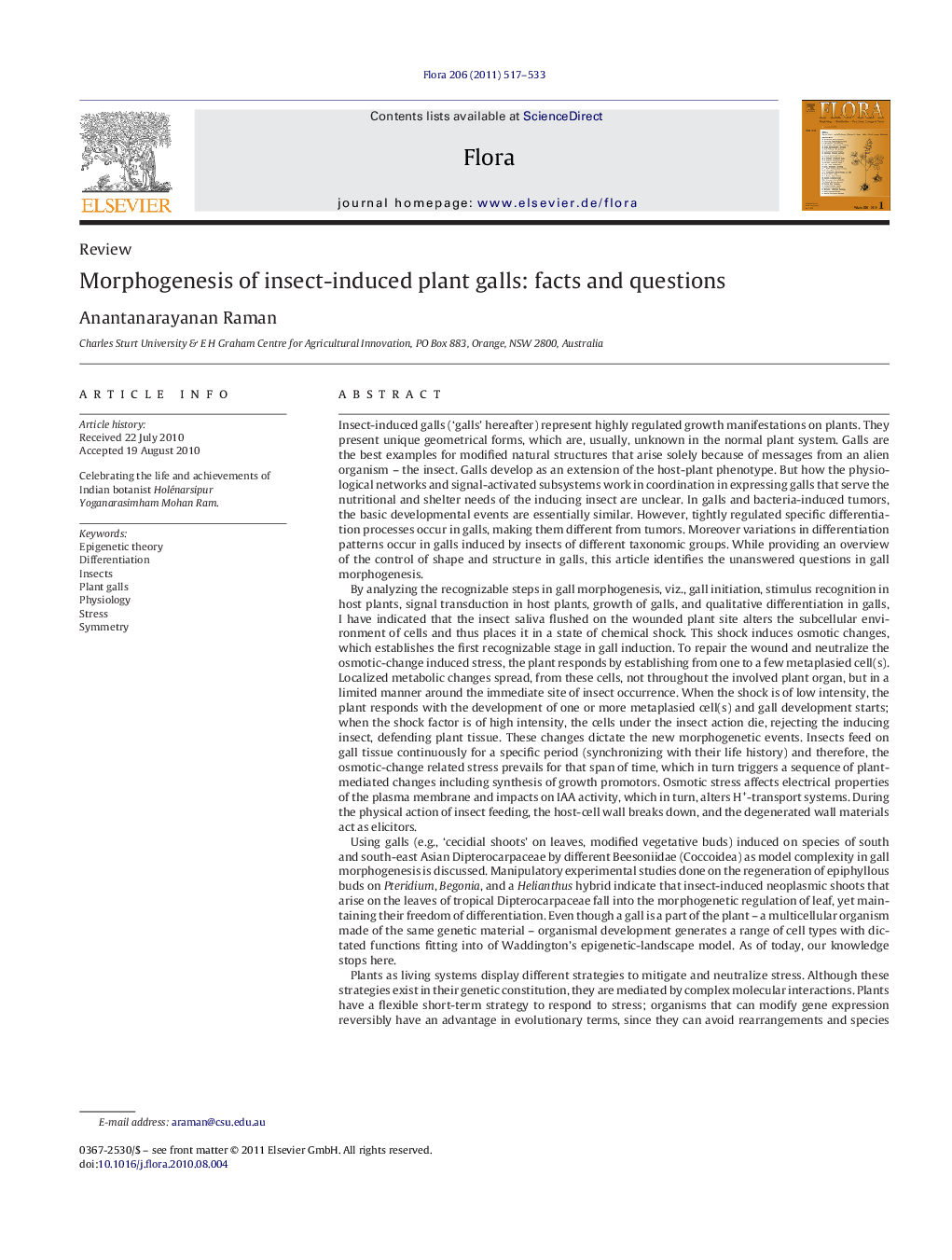| کد مقاله | کد نشریه | سال انتشار | مقاله انگلیسی | نسخه تمام متن |
|---|---|---|---|---|
| 2179747 | 1095077 | 2011 | 17 صفحه PDF | دانلود رایگان |

Insect-induced galls (‘galls’ hereafter) represent highly regulated growth manifestations on plants. They present unique geometrical forms, which are, usually, unknown in the normal plant system. Galls are the best examples for modified natural structures that arise solely because of messages from an alien organism – the insect. Galls develop as an extension of the host-plant phenotype. But how the physiological networks and signal-activated subsystems work in coordination in expressing galls that serve the nutritional and shelter needs of the inducing insect are unclear. In galls and bacteria-induced tumors, the basic developmental events are essentially similar. However, tightly regulated specific differentiation processes occur in galls, making them different from tumors. Moreover variations in differentiation patterns occur in galls induced by insects of different taxonomic groups. While providing an overview of the control of shape and structure in galls, this article identifies the unanswered questions in gall morphogenesis.By analyzing the recognizable steps in gall morphogenesis, viz., gall initiation, stimulus recognition in host plants, signal transduction in host plants, growth of galls, and qualitative differentiation in galls, I have indicated that the insect saliva flushed on the wounded plant site alters the subcellular environment of cells and thus places it in a state of chemical shock. This shock induces osmotic changes, which establishes the first recognizable stage in gall induction. To repair the wound and neutralize the osmotic-change induced stress, the plant responds by establishing from one to a few metaplasied cell(s). Localized metabolic changes spread, from these cells, not throughout the involved plant organ, but in a limited manner around the immediate site of insect occurrence. When the shock is of low intensity, the plant responds with the development of one or more metaplasied cell(s) and gall development starts; when the shock factor is of high intensity, the cells under the insect action die, rejecting the inducing insect, defending plant tissue. These changes dictate the new morphogenetic events. Insects feed on gall tissue continuously for a specific period (synchronizing with their life history) and therefore, the osmotic-change related stress prevails for that span of time, which in turn triggers a sequence of plant-mediated changes including synthesis of growth promotors. Osmotic stress affects electrical properties of the plasma membrane and impacts on IAA activity, which in turn, alters H+-transport systems. During the physical action of insect feeding, the host-cell wall breaks down, and the degenerated wall materials act as elicitors.Using galls (e.g., ‘cecidial shoots’ on leaves, modified vegetative buds) induced on species of south and south-east Asian Dipterocarpaceae by different Beesoniidae (Coccoidea) as model complexity in gall morphogenesis is discussed. Manipulatory experimental studies done on the regeneration of epiphyllous buds on Pteridium, Begonia, and a Helianthus hybrid indicate that insect-induced neoplasmic shoots that arise on the leaves of tropical Dipterocarpaceae fall into the morphogenetic regulation of leaf, yet maintaining their freedom of differentiation. Even though a gall is a part of the plant – a multicellular organism made of the same genetic material – organismal development generates a range of cell types with dictated functions fitting into of Waddington's epigenetic-landscape model. As of today, our knowledge stops here.Plants as living systems display different strategies to mitigate and neutralize stress. Although these strategies exist in their genetic constitution, they are mediated by complex molecular interactions. Plants have a flexible short-term strategy to respond to stress; organisms that can modify gene expression reversibly have an advantage in evolutionary terms, since they can avoid rearrangements and species diversification. Mechanisms of DNA methylation and histone modifications possibly regulate inheritance of stress ‘memories’. Inherited genetic traits also play a role in gall morphogenesis, followed by roles played by correlating morphogenetic factors. An articulated reconstruction of the developmental process commencing from either one or a group of metaplasied cells that gets transmitted through subsequent growth promoter-mediated cell expansion, until the commitment of the metaplastic cell and those in its neighbourhood enabling the start of ‘novel’ cell-cycle patterns, cell multiplication, programmed differentiation, and control is needed to explain symmetry – a morphogenetic phenomenon that makes the insect-induced galls distinct from the bacteria-induced tumors.
Journal: Flora - Morphology, Distribution, Functional Ecology of Plants - Volume 206, Issue 6, June 2011, Pages 517–533